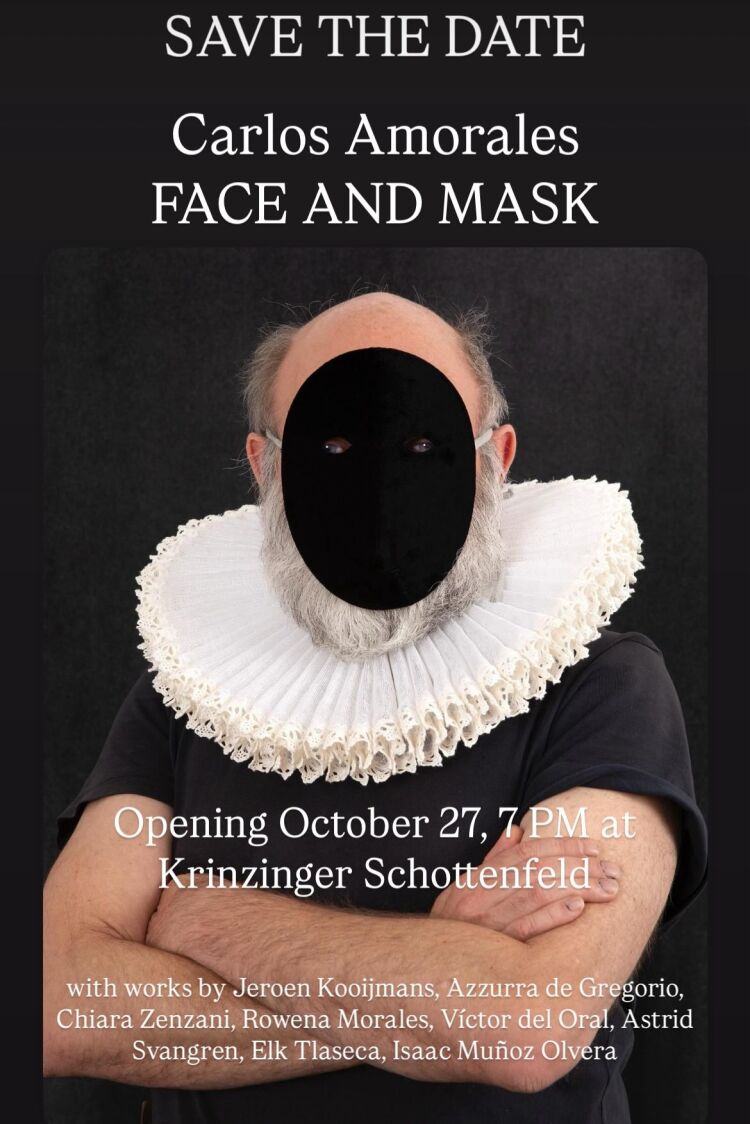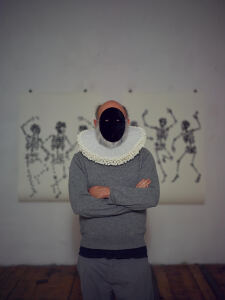FACE AND MASK

Krinzinger Schottenfeld
Face and Mask
Carlos Amorales
 with works by Jeroen Kooijmaans , Azzurra de Gregorio , Chiara Zenzani , Rowena Morales , Víctor del Moral , Astrid Svangren , Eric Tlaseca , Issac Olvera.
with works by Jeroen Kooijmaans , Azzurra de Gregorio , Chiara Zenzani , Rowena Morales , Víctor del Moral , Astrid Svangren , Eric Tlaseca , Issac Olvera.
Schottenfeldgasse 45, 1070 Vienna
Face and Mask
Carlos Amorales turns the mask into a mirror of our time. It is not merely an ornament or disguise, but a territory where identity, myth, and power intersect.
This new exhibition reveals how what the mask conceals ends up showing with greater force: the fragility of the human in the face of technology, the tension between the local and the global, between the intimate and the collective. Far from conceiving the face or the mask as an aesthetic or ritual accessory, the artist places them at the center of a reflection that questions identity, representation, and the politics of the image in the digital age.
Since ancient times, the mask has served as a mediator between the self and the other, between the human and the divine, between the visible and the hidden. Amorales takes up this symbolic device and inserts it into a field of current tensions, where the face and mask become a space of social recognition and subjectivity confronted with media saturation, technological control, and the precariousness of cultural narratives in globalization.
The dialogue established with the iconic figure of El Santo, the Silver-Masked Man, is fundamental. By recovering this symbol of Mexican identity, Carlos not only refers to a popular icon, but also exposes the fragility of collective identities in the face of global discourse. The wrestling mask, which in its original context protects while simultaneously constructing a myth, here becomes a metaphor for a lost search for identity, an attempt to cling to cultural signs in the face of homogenization.
The critique is enriched by the reference to Roland Barthes: myth as a mask that conceals ideologies. In this sense, Amorales’ work not only plays with visual surface, but also reveals how the images we consume and produce in the digital age reproduce naturalized falsehoods, legitimizing structures of power. The mask, in his proposal, ceases to be a simple object and becomes a mechanism for critical reading of the contemporary.
Taken as a whole, Face and Mask transcends the formalism of portraiture or visual object. His drawings and audiovisuals function as critical essays that invite viewers to rethink not only the function of the mask, but also the nature of identity in a present shaped by screens, algorithms, and globalized narratives. Carlos manages to turn the unsettling quality of the mask—its capacity to simultaneously conceal and reveal—into fertile ground for questioning the tensions between art, technology, and ideology.
In the exhibition Face and Mask, eight artists from different latitudes engage in dialogue with the work of Carlos Amorales, taking the mask as their starting point. From diverse disciplines—installation, performance, visual arts, painting, and sculpture—each proposal turns the mask into a territory of meanings in constant transformation: identity and anonymity, ritual and resistance, concealment and revelation. This collective space not only broadens the reading of Amorales’ work, but also invites the public to discover how the mask, beyond its form, remains a living symbol that connects cultures, memories, and contemporary sensibilities.
The title of this exhibition is inspired by a work of Hans Belting, whose reflections have decisively shaped the contemporary studies on images.
Oscarito Sanchez

No comments